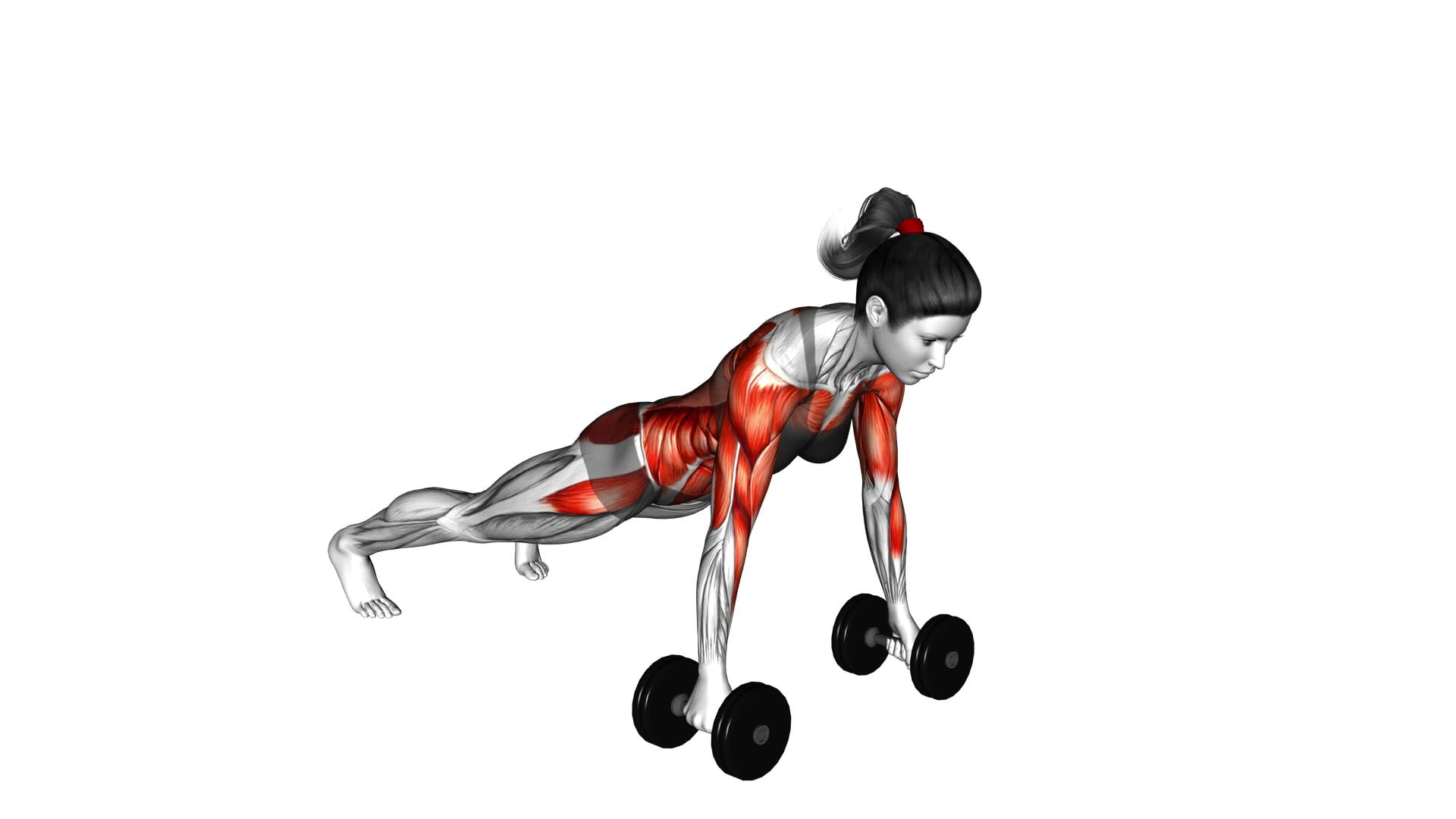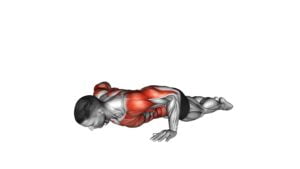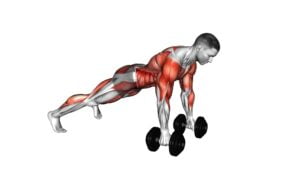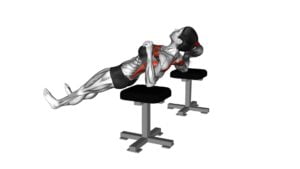Push-up Row (female) – Video Exercise Guide & Tips

Get ready to level up your fitness routine with the push-up row! This dynamic exercise targets your upper body and core, giving you a full-body workout.
Watch This Exercise Video
In this video exercise guide, we'll show you the proper form and technique for the push-up row, along with modifications for beginners and advanced variations for a challenge.
Maximize your results and achieve your fitness goals with these tips.
Let's get started!
Key Takeaways
- Targets multiple muscle groups simultaneously
- Increases upper body strength
- Improves core stability
- Enhances muscle activation
Benefits of the Push-up Row
You can experience numerous benefits from incorporating the push-up row into your workout routine. This compound exercise combines the benefits of a push-up and a row, targeting multiple muscle groups simultaneously. One of the main benefits of the push-up row is increased upper body strength. By engaging your chest, shoulders, triceps, and back muscles, you can develop a stronger and more toned upper body. Additionally, this exercise also improves core stability as you engage your abdominal muscles to maintain proper form.
Another benefit of the push-up row is its versatility. There are various ways to perform this exercise, allowing you to switch up your routine and target different muscle groups. You can use dumbbells, kettlebells, or resistance bands to add an extra challenge and increase muscle activation. Alternatively, you can modify the exercise by performing it on an incline or decline to engage different muscle fibers. By incorporating different variations of the push-up row into your workout routine, you can prevent plateaus and continue to challenge your body.
Now that you understand the benefits of the push-up row, let's move on to proper form and technique to ensure you perform this exercise correctly and maximize its effectiveness.
Proper Form and Technique
To perform the push-up row with proper form and technique, it's crucial to focus on three key points.
Firstly, ensure that your elbows stay close to your body and maintain proper alignment with your back throughout the movement.
Secondly, remember to breathe in on the way down and exhale as you pull the weight up, allowing for optimal oxygen flow and muscle activation.
Lastly, engage your core muscles throughout the exercise to maintain stability and prevent any strain on your lower back.
Mastering these points will help you maximize the effectiveness of the push-up row and minimize the risk of injury.
Elbows and Back Alignment
Maintain proper alignment of your elbows and back during the Push-up Row exercise. This is crucial for maximizing the effectiveness of the exercise and minimizing the risk of injury. Here are some important tips to keep in mind:
- Elbows Positioning: Make sure your elbows are close to your body and pointing backward, not out to the sides. This helps engage the correct muscles and prevents unnecessary strain on your shoulders.
- Back Alignment: Keep your back straight and avoid arching or sagging. Engage your core muscles to maintain a stable and neutral spine throughout the movement.
- Common Mistakes: Avoid allowing your elbows to flare out, as this puts stress on your shoulder joints. Also, be mindful not to round your upper back or let your hips sag towards the floor.
- Practice Proper Form: Start with lighter weights or no weights at all to focus on mastering the correct form. Gradually increase the difficulty as you become more comfortable and confident in your technique.
Breathing During Exercise
Proper breathing technique is crucial for maximizing the effectiveness of the Push-up Row exercise and maintaining proper form. When performing this exercise, it's important to synchronize your breathing with the movement to optimize oxygen intake and enhance your overall performance.
Here are some breathing techniques to keep in mind during the exercise:
- Inhale: As you lower your body towards the ground, take a deep breath in through your nose. This helps to expand your lungs and prepare your body for the exertion.
- Exhale: As you push your body back up and perform the rowing movement, exhale forcefully through your mouth. This helps to engage your core muscles and provide stability during the exercise.
By focusing on your breathing and maintaining a steady rhythm, you can ensure that your muscles receive an adequate supply of oxygen, improving endurance and preventing fatigue.
Core Engagement Importance
Engaging your core is crucial for maintaining proper form and technique during the Push-up Row exercise. A strong core not only helps you perform the exercise correctly but also offers several benefits for your overall fitness. Here are some reasons why core engagement is important and some core exercises for beginners:
- Stability: By engaging your core, you stabilize your body and maintain a strong foundation, preventing any unnecessary movements or strain on your lower back.
- Balance: Core engagement improves your balance and stability, allowing you to perform the exercise with better control and coordination.
- Strength: A strong core enhances your overall strength and power, enabling you to execute the Push-up Row exercise more effectively.
- Injury prevention: Engaging your core helps protect your spine and surrounding muscles, reducing the risk of injury during the exercise.
To strengthen your core, consider incorporating exercises like planks, bird dogs, Russian twists, and bicycle crunches into your workout routine. Remember to focus on proper form and technique to maximize the benefits of your core engagement.
Equipment Needed for the Exercise
To perform the Push-up Row exercise, you'll need a pair of dumbbells. Dumbbells are essential for this exercise as they provide the resistance needed to target and strengthen your upper body muscles effectively. They allow you to increase or decrease the weight according to your fitness level and goals.
In addition to dumbbells, you may also consider incorporating resistance bands into your Push-up Row routine. Resistance bands are versatile and can add an extra challenge to your workout by providing additional resistance. They're lightweight and portable, making them convenient for home or travel workouts.
When choosing dumbbells and resistance bands, it's important to select the appropriate weight and resistance level for your fitness level. Start with a weight and resistance that challenges you, but still allows you to maintain proper form throughout the exercise. As you progress and get stronger, you can gradually increase the weight or resistance to continue challenging your muscles.
Remember to always consult with a fitness professional before starting any new exercise program, especially if you have any pre-existing medical conditions or injuries. They can provide guidance on selecting the right equipment and ensure that you perform the exercises safely and effectively.
Modifications for Beginners
For beginners, start by performing the Push-up Row exercise with lighter weights and focus on maintaining proper form throughout the movement. Here are some modifications and progression exercises to help you build up to the full Push-up Row:
- Common mistakes to avoid during push-up rows:
- Arching your back: Keep your core engaged and maintain a straight line from your head to your heels.
- Dropping your hips: Keep your hips level with your shoulders to avoid straining your lower back.
- Flaring your elbows: Keep your elbows close to your body to target your triceps and avoid shoulder strain.
- Rushing the movement: Take your time and perform each rep with control to maximize the benefits.
- Progression exercises to build up to the full Push-up Row:
- Knee push-up rows: Start by performing push-up rows on your knees to reduce the amount of weight you're lifting.
- Elevated push-up rows: Place your hands on an elevated surface, like a bench or step, to decrease the difficulty and gradually increase the challenge as you get stronger.
- Resistance band rows: Attach a resistance band to a sturdy anchor and perform rows with the band to work on your upper body strength.
Remember to listen to your body and progress at a pace that feels comfortable for you. With consistent practice and proper form, you'll be able to master the Push-up Row exercise in no time.
Advanced Variations for a Challenge
To further challenge yourself, try incorporating advanced variations of the Push-up Row exercise. These advanced modifications won't only increase the difficulty of the exercise but also activate different muscle groups.
One advanced variation is the Spiderman Push-up Row, where you perform a push-up while bringing one knee towards your elbow on the same side. This variation targets your core and obliques, providing a greater challenge for your stability and strength.
Another advanced modification is the Plyometric Push-up Row, where you explosively push yourself off the ground after each push-up, adding an element of power and explosiveness to the exercise. This modification will engage your fast-twitch muscle fibers and elevate your heart rate, making it a great option for a high-intensity workout.
By incorporating these advanced modifications and muscle activation techniques, you can take your Push-up Row exercise to the next level and continue to challenge your body.
Now, let's move on to the next section for tips on how to maximize your results and get the most out of your Push-up Row workout.
Tips for Maximizing Results
Maximize your results by incorporating these tips to enhance the effectiveness of your Push-up Row workout:
- Maintain proper form: One of the most common mistakes people make during Push-up Rows is sacrificing form for the sake of completing more reps. Focus on keeping your body in a straight line from head to toe and engage your core throughout the exercise.
- Use the recommended rep range: To maximize your results, aim to perform Push-up Rows within the recommended rep range. Typically, this exercise is done for 8-12 reps per set. This range allows you to challenge your muscles while maintaining good form.
- Control your movements: Avoid rushing through the exercise. Slow and controlled movements will engage your muscles more effectively, leading to better results. Focus on feeling the contraction in your back muscles as you lift the dumbbell.
- Gradually increase weight: As you become comfortable with the exercise, gradually increase the weight of the dumbbell to continue challenging your muscles. This progressive overload will help you build strength and achieve better results over time.
Frequently Asked Questions
How Many Calories Can I Burn by Doing the Push-Up Row Exercise?
You can burn calories by doing the push-up row exercise. It's a great way to engage multiple muscles and increase your heart rate.
However, the number of calories burned will vary depending on factors like your weight, intensity, and duration of the exercise.
To ensure shoulder injury safety, make sure to maintain proper form and avoid any discomfort or pain. Consult a fitness professional for personalized advice.
Can the Push-Up Row Help Improve Posture?
To improve your posture and upper body strength, the push-up row exercise is a great choice. By incorporating this exercise into your routine, you can strengthen your back, shoulders, and core muscles, which all play a vital role in maintaining good posture.
Additionally, the push-up row requires proper form and engagement of multiple muscle groups, helping to develop overall body stability.
Is It Safe to Do the Push-Up Row if I Have a Shoulder Injury?
If you have a shoulder injury, it's important to prioritize safety when choosing exercises. The push-up row may not be the best option for shoulder rehabilitation. Instead, consider alternative exercises that put less stress on the shoulder joint, such as resistance band exercises or modified push-ups with knees on the ground.
Always consult with a healthcare professional or physical therapist to determine the safest exercises for your specific injury.
How Long Should I Rest Between Sets When Performing the Push-Up Row?
When performing the push-up row, it's important to consider the rest duration between sets. Resting adequately allows your muscles to recover and prevents overexertion.
The ideal rest duration for the push-up row is typically around 1-2 minutes. However, this can vary depending on your fitness level and personal preferences.
Remember to prioritize proper form during the exercise to avoid injury and maximize results.
Can the Push-Up Row Help Strengthen My Core Muscles?
Yes, the push-up row can definitely help strengthen your core muscles.
This exercise combines the benefits of a push-up and a row, targeting not only your upper body but also engaging your abs, obliques, and lower back.
By stabilizing your body and resisting rotation while performing the row, your core muscles are forced to work harder, leading to increased core strength.
Incorporating the push-up row into your workout routine can be an effective way to strengthen and tone your core.
Conclusion
Incorporating push-up rows into your workout routine can provide numerous benefits. This includes improved upper body strength and stability. By following the proper form and technique, using the necessary equipment, and making modifications or advanced variations as needed, you can maximize your results from this exercise.
Remember to consult with a fitness professional to ensure you're performing push-up rows correctly and safely. Start incorporating this challenging exercise into your workouts and see the difference it can make.

Author
Years ago, the spark of my life’s passion ignited in my mind the moment I stepped into the local gym for the first time. The inaugural bead of perspiration, the initial endeavor, the very first surge of endorphins, and a sense of pride that washed over me post-workout marked the beginning of my deep-seated interest in strength sports, fitness, and sports nutrition. This very curiosity blossomed rapidly into a profound fascination, propelling me to earn a Master’s degree in Physical Education from the Academy of Physical Education in Krakow, followed by a Sports Manager diploma from the Jagiellonian University. My journey of growth led me to gain more specialized qualifications, such as being a certified personal trainer with a focus on sports dietetics, a lifeguard, and an instructor for wellness and corrective gymnastics. Theoretical knowledge paired seamlessly with practical experience, reinforcing my belief that the transformation of individuals under my guidance was also a reflection of my personal growth. This belief holds true even today. Each day, I strive to push the boundaries and explore new realms. These realms gently elevate me to greater heights. The unique combination of passion for my field and the continuous quest for growth fuels my drive to break new ground.







